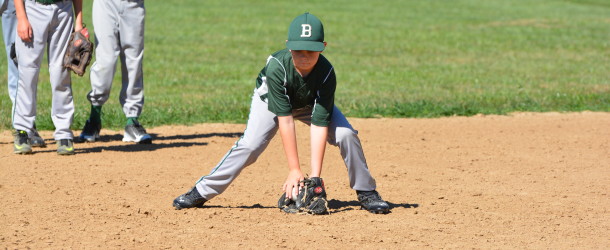Drills are the lifeblood of skill development. Whether it be for Major Leaguers as a part of their daily routine, or Little Leaguers as their means of learning the basic skills of the game, it’s in the batting cages and backyards where ability is truly cultivated. Drills allow you to isolate a specific part of a specific skill that, when put together, help develop the overall talent of the individual player.
With regard to the fundamentals of fielding a routine ground ball, a focus must be placed not only on the hands, but also more importantly, on the feet. Most understand that all good infielders possess good, soft hands. Well, when you see those sure-handed infielders, be sure to take notice of what their feet are doing. The two work together, and below is a drill progression that will help improve both.
HANDS ROUTINE
Rolling balls to an infielder is much like a hitter working off of the tee. It’s a very simple starting point to a skill that can be done with kids who struggle to consistently catch a ball, all the way up to a Gold Glove winning Big Leaguer looking to hone his craft. The challenging level of this drill works hand in hand with the talent level of the player, where balls can be rolled (from ten to twenty feet away) softly underhand for someone just learning the game, or firmly like skipping rocks on water for those with some ability. While its focus may be different, the actual drill is the same. Here are three parts to what could be a daily hands routine.
KNEES
By starting on the knees, we are taking the lower half completely out of the fundamentals of fielding a ground ball to allow for complete and total focus on the physical act of catching the ball. First and foremost, glove angle can be a major point of emphasis, just to get the glove as “big” as possible. Think fingers down, with the palm facing the direction where the ball is coming from. Do that, and the glove is open at it’s max. If the glove can catch raindrops, with it’s back flat on the ground, the glove is actually becomes smaller than what it could be. Being down on both knees also forces players to field the ball out in front of their bodies, with their eyes behind the ball. Draw a triangle in the dirt where the knees are its base, and have the player focus on fielding the ball at the triangle’s point. Lastly, the hand roll while on the knees finishes with the player bringing the ball to center, where the majority of all throws for infielders start. The hands “give” with the ball, and are funneled in towards the belly-button/chest. The ball is an egg… catch it like an egg! That’s what soft hands are all about.
WIDE BASE
All good infielders work from the ground up, from low to high. The wide base segment of the hands routine adds the lower half into the picture by putting players back on their feet, shoulder-width apart. But rather than incorporating any footwork just yet, the feet are planted to the ground, and the focus moves to getting low by bending at the knees, not at the waist. In a half-squat of sorts, the knees will move over the feet, as the butt gets closer to the ground in an athletic position. When it comes time to catch the ball, nothing changes from exactly how the ball is secured when previously being on both knees, with the glove open, ball out front, then brought to center.
FOOTWORK
The final piece of the hands routine puzzle finally gets the feet into play. The feet play two roles for infielders: first, they set the hands up to field, and soon thereafter, set the arm up to throw. With the ball rolling, the footwork to field is as simple as right-left-field. The right foot gets the infielder low to the ball, and the left foot steps thru the ball, all while in that same position to field as in the wide base, and catching the ball the same way as when on the knees. From there, the feet are replaced, right-left setting up to throw, with the front shoulder closed and pointing directly at the target. Right-left-field… right-left-throw.
FOUR CORNERS
As we build an infielder’s fundamental skills one step at a time, different drills enable us to put everything together and see how they work. None do that better than four corners. With a player at each corner, the ball is thrown around in every direction imaginable- around the horn, reverse around the horn, across, or anywhere- mimicking so many different types of throws and catches that will undoubtedly come up over the course of the season.
It is the mother of all infield drills where just about anything you can imagine happening for infielders we can simulate in one variation of four corners or another. Routine ground balls. Double-play feeds. Slow rollers. Relay re-directs. So many aspects of infield play can be simulated in four corners, with footwork as the drill’s focus, while adding in both fielding and throwing as well. When the feet are working properly, the byproduct is solid, athletic fielding and throwing mechanics. Using just a little creativity, four corners can be a staple of daily workouts, with a different point of emphasis every single day.
Three different sized corners each offer different elements to work on. At 20 to 30 feet apart, it is the perfect size to work on underhand feeds for not just middle guys, but corner guys as well. Flipping the ball in the around the horn direction is like a left side of the field double play feed or a first baseman feeding the pitcher, while going reverse around the horn is geared for the right side infielder DP. A box set between 30-40 feet enables work on that shorter overhand throw that doesn’t need the legs behind it, like a middle infielder moving away from the base on a force play at 2nd. From there, opening up to a 50-70 foot box with your infielders, really gives a ton of flexibility as to what to work on. Rolling the ball to the left, and throwing across builds the fundamentals needed to make a routine play. Simply throwing the ball around the horn is the same as turning a 5-4-3 double play in a game- it’s the feed for a third baseman, or the pivot for a second baseman. It can even been a potential World Series game-ending throw to the plate for a first baseman!







Comments are closed.